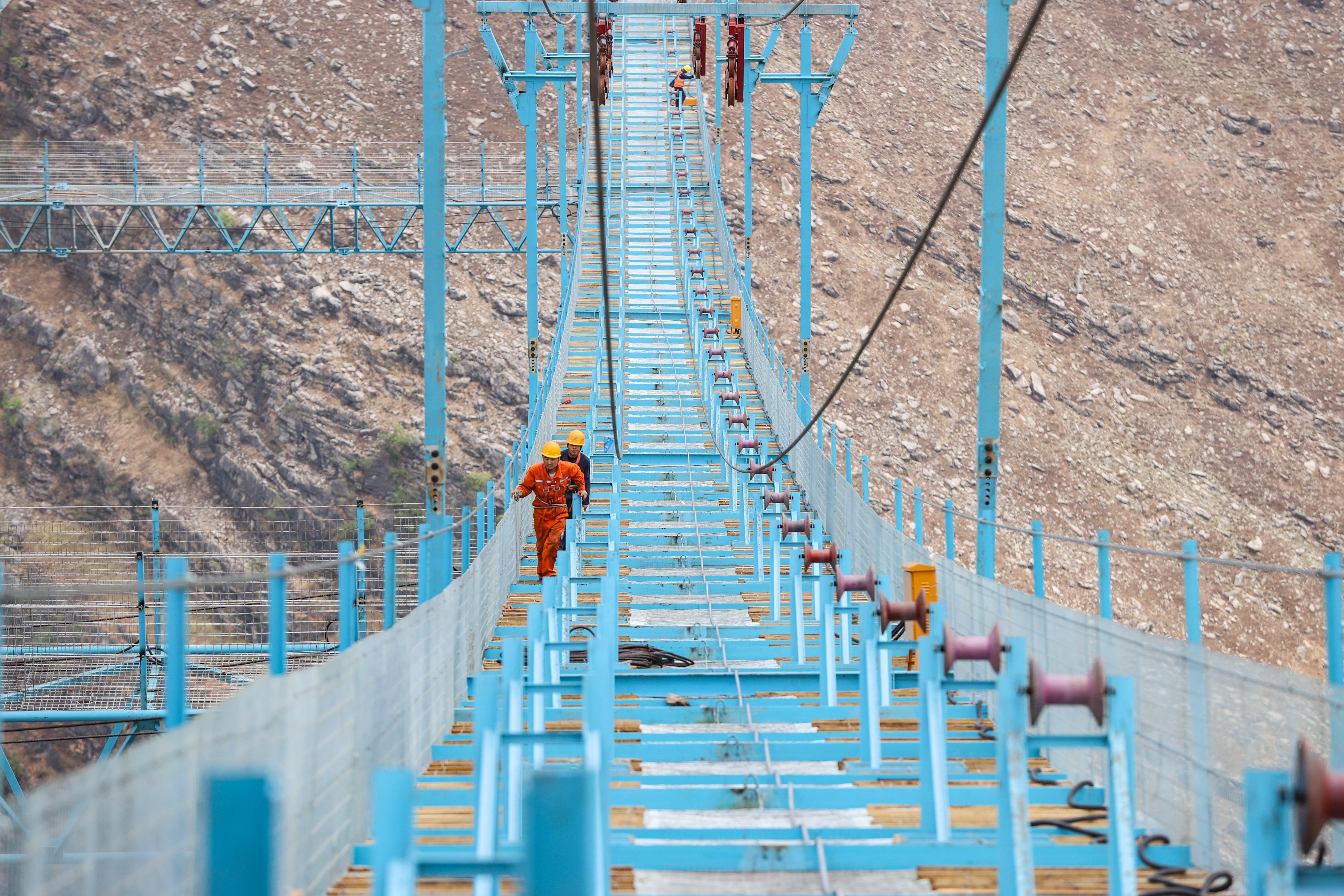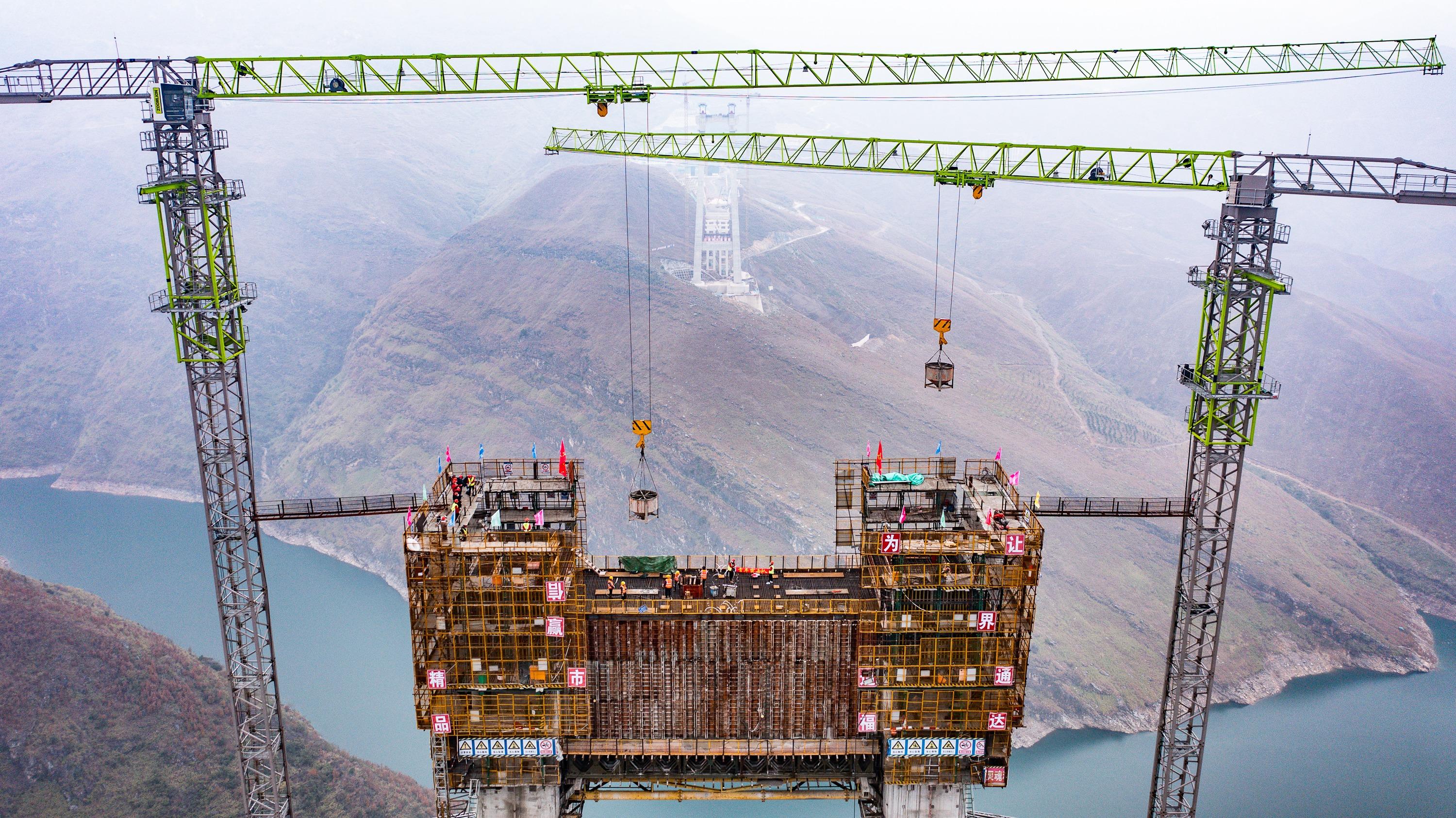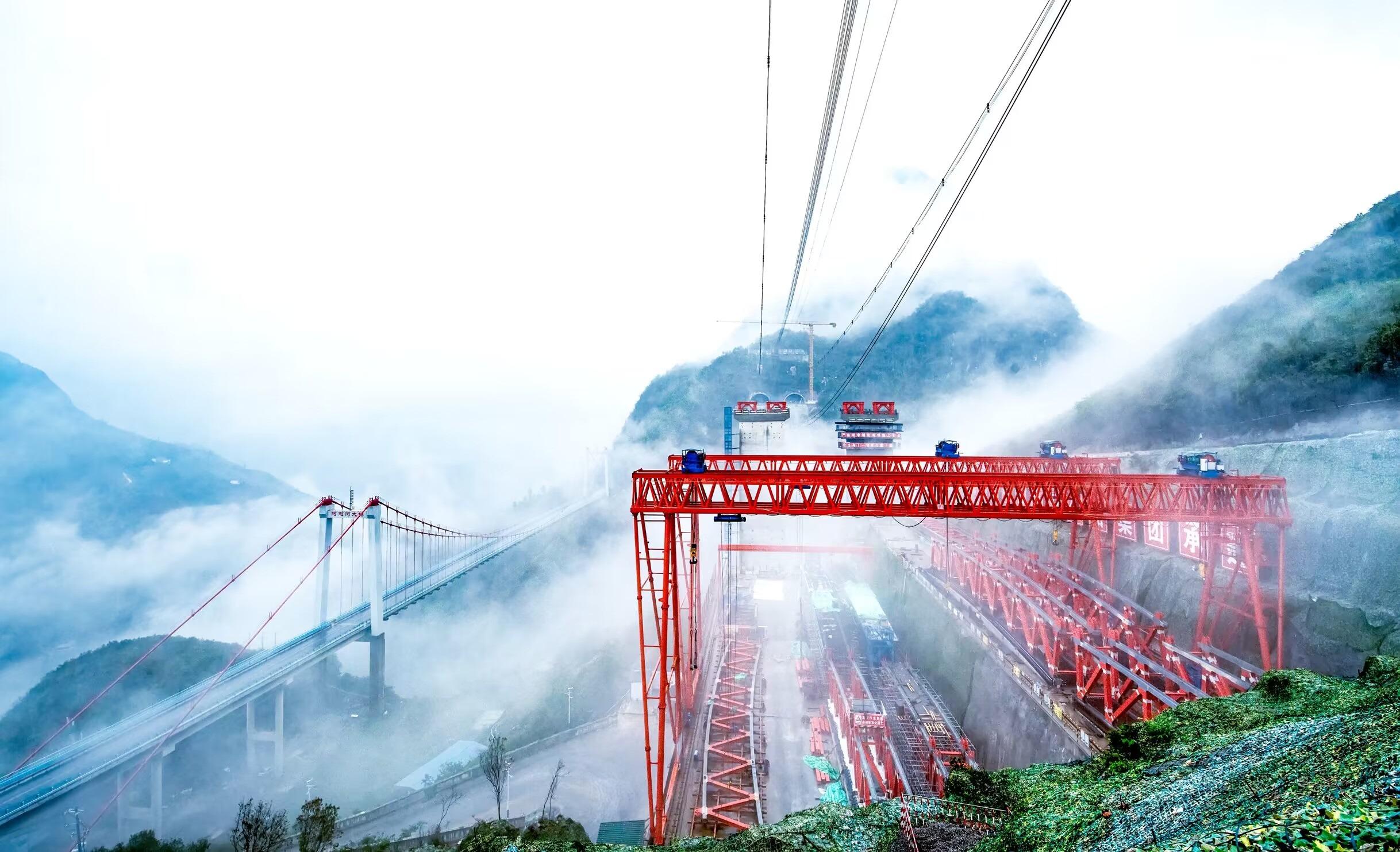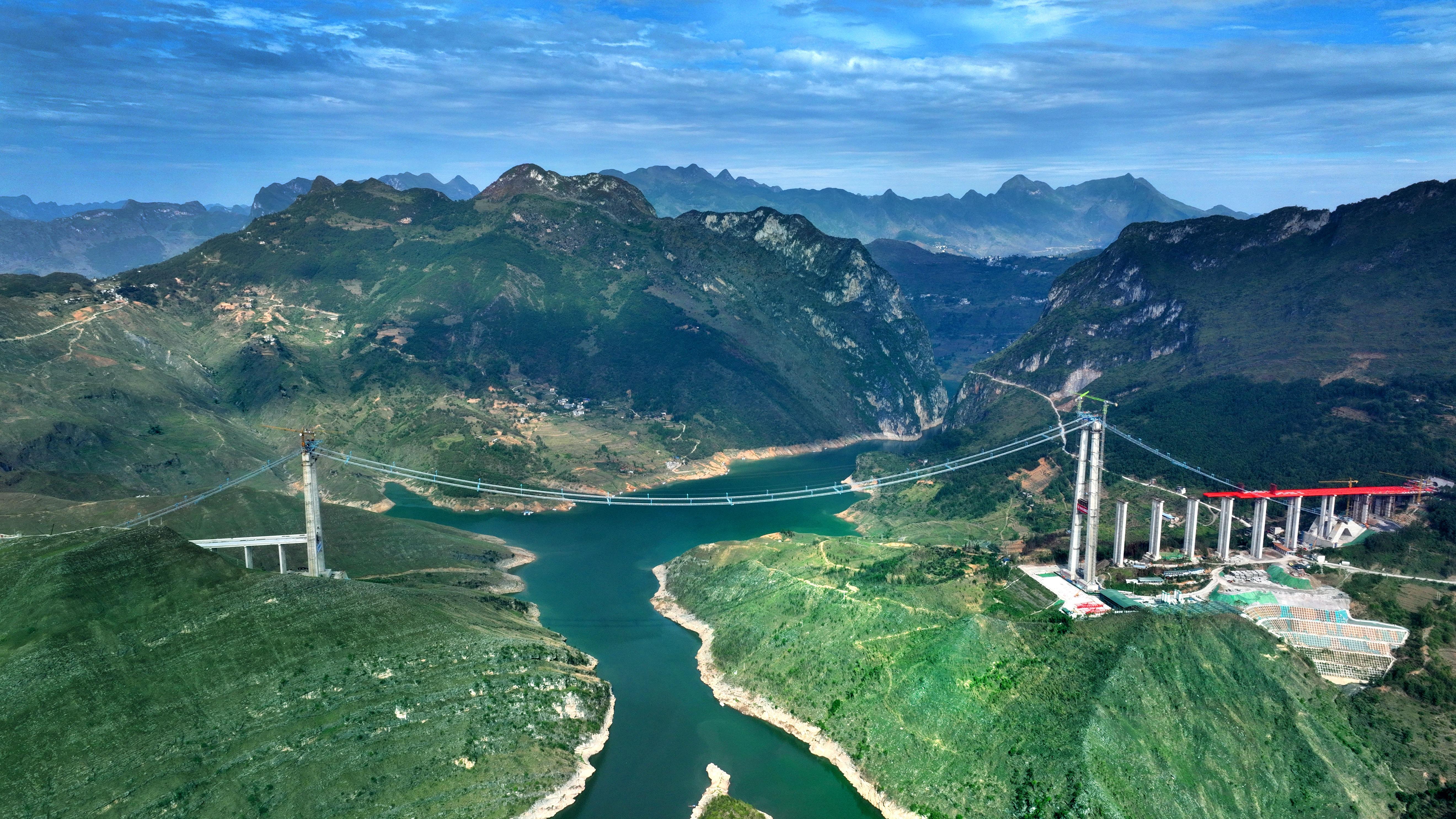The structures will boost connectivity, improve the local economy and raise people's living standards. Luo Wangshu reports from Liupanshui, Guizhou.
 Workers use a special walkway as they construct the Zangke River Bridge in Qinglong county, Guizhou province, on May 1. (PHOTO / CHINA NEWS SERVICE)
Workers use a special walkway as they construct the Zangke River Bridge in Qinglong county, Guizhou province, on May 1. (PHOTO / CHINA NEWS SERVICE)
From their workplace, Tang Qiguo and his two colleagues enjoy breathtaking views that probably beat those seen from 99 percent of office penthouses anywhere in the world.
The three men work with the clouds below their feet and fog at their fingertips. Looking down, they can see a river flowing through a valley, encompassed by mountains.
They are construction workers on the Zangke River Bridge, one of the most important projects along a new freeway set to link Nayong and Qinglong in the southwestern province of Guizhou.
The structure is like a massive swing hanging between the mountains, high above the river. Tang, 21, and his peers affix cables at a height of some 200 meters, the equivalent of about an 88-story building.
To do this, they use two special walkways that run about 1 kilometer on either side. The walkways, made from wooden planks and metal grids, are fenced in for safety reasons.
Although both the engineers and construction workers say the walkways are quite safe, people have to be able to conquer their fear of heights to walk on them.
However, that isn't a problem for Tang or his colleagues, who traverse the walkways as easily as if they were walking along a street — albeit one more than 200 meters above the ground.
 Concrete is lifted onto the main tower of the Zangke River Bridge on Dec 30. (PHOTO / XINHUA)
Concrete is lifted onto the main tower of the Zangke River Bridge on Dec 30. (PHOTO / XINHUA)
Construction is expected to be completed in August next year. Once finished, the bridge will slash the journey across the valley from one hour to about 60 seconds, greatly benefiting the residents of the mountainous area.
The project reflects the ambitions for the development of transportation in Guizhou, a mountainous province with little flat land. Those geographical difficulties have long hampered development, and Guizhou was once one of China's poorest provinces.
Compared with the plains, building a transportation network through Guizhou's mountains requires advanced technological solutions, while construction costs are far higher because many tunnels and bridges are required.
According to the provincial transportation commission, there are nearly 30,000 bridges dotted along the region's 210,000-km road network, 8,331 km of which consists of freeways.
In 1949, when the People's Republic of China was founded, there were just 357 bridges in Guizhou.
The new bridges are not only links to facilitate social and economic development, they are also "calling cards" that demonstrate the country's accomplishments within the sphere of the transportation infrastructure.
 A photo shows the casting yard of the Wumengshan Bridge, one of the major construction projects along a new freeway that is set to link Nayong and Qinglong in Guizhou. (PHOTO PROVIDED TO CHINA DAILY)
A photo shows the casting yard of the Wumengshan Bridge, one of the major construction projects along a new freeway that is set to link Nayong and Qinglong in Guizhou. (PHOTO PROVIDED TO CHINA DAILY)
Winning awards
Guizhou is home to all four types of bridge: suspension cable; cable-stayed; arched; and beam.
"There are about 28,000 bridges on Guizhou's roads. If linked together, they would extend more than 5,400 km, farther than a round trip between Beijing and Guiyang, the provincial capital, and also long enough to cross the Chinese mainland," said Xu Xianghua, chief engineer at the Guizhou Transportation Commission.
By the end of last year, nearly half the world's 100 tallest bridges, and four of the 10 tallest bridges, were in Guizhou. Fifteen have won 25 domestic and international awards, while four have won the Gustav Lindenthal Medal.
The medal is one of the most prestigious bridge construction awards in the world, and only five other bridges in China have won it.
Technology, innovation
The 1,849-meter-long Zangke River Bridge is located within the Wumengshan National Geological Park and it spans the Zangke River.
"It is a double-tower, single-span steel truss suspension bridge. The longest drop between the bridge deck and the river is 380 meters. When completed, it will be the 11th highest of the world's 100 tallest bridges," said Zhao Mingfu, the engineer leading construction.
The bridge crosses the meeting point of four counties and districts-Qinglong, Pu'an, Shuicheng and Liuzhi — and will benefit the residents of all those places, and it will also boost economic development, Zhao added.
Engineers devised five technological innovations and 10 management innovations to ensure safety during construction, he noted.
For example, they are using a special alloy on the sealed rope sling, which prevents substances such as dust and rust from damaging the surface. They have also made use of new materials to make the cable, which has superior resistance to corrosion.
 An aerial photo shows the 1,849-meter-long Zangke River Bridge, which is under construction in the Wumengshan National Geological Park in Guizhou. (PHOTO PROVIDED TO CHINA DAILY)
An aerial photo shows the 1,849-meter-long Zangke River Bridge, which is under construction in the Wumengshan National Geological Park in Guizhou. (PHOTO PROVIDED TO CHINA DAILY)
Safety prioritized
The team is focused on safety. Workers are encouraged to take online quizzes about safety issues by scanning a QR code posted at the construction site.
By answering the questions, they can earn points that can be used to purchase supplies and snacks at the site. "It is an innovative way to encourage workers to pay attention to safety issues. They can also report safety issues to earn points," said Ran Maolun, general manager of the Guizhou Naqing Freeway Corp, which is building the road that will link Nayong and Qinglong.
About 30 minutes by road from the Zangke River Bridge, another bridge is under construction for the freeway.
The Wumengshan Bridge, which crosses the Azhi River, has been designed using a unique form of arched structure.
"Due to the complicated geography and terrain, it is the first bridge in the world to use such a structure," said Liu Xiaofan, the engineer leading construction of the bridge. "The design will help reduce the weight of the bridge. Compared with other concrete arch bridges, it will also greatly save on the amount of concrete used."
As the bridge is located in the Wumengshan National Geological Park, the designers have worked hard to reduce the environmental impact.
"During construction, we are digging in a terraced pattern, with the aim of reducing the amount of excavation needed," Liu said.
Usually, the temporary anchorages on both sides of a bridge are dismantled after completion.
However, in this case, instead of dismantling the anchorages, the engineers have envisaged their long-term use, he said, noting that other advanced "green construction" concepts are also being applied in the project.
Dreams come true
The bridges will link mountainous Guizhou with the rest of the country, fulfilling the dreams of generations of construction workers to make the province easier to reach by road.
Shen Xiuqiao, a Guizhou native, is a construction worker on the Zangke River Bridge. His father, who also worked on roads and bridges, named him Xiuqiao because it means "building bridges" in Mandarin.
"I've been building roads and bridges for more than 20 years. I'm very excited to see more and more bridges being built here," Shen said.
He added that he is proud of his father and grandfather, both of whom built roads and bridges and tried to make Guizhou a better and more easily accessible place.
Contact the writer at luowangshu@chinadaily.com.cn


